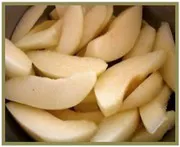 The growth of microbial load and the tissue browning are the main factors in terms of quality loss for fresh-cut pears during storage.
The growth of microbial load and the tissue browning are the main factors in terms of quality loss for fresh-cut pears during storage.The application of chitosan edible coating with anti-browning agents (ascorbic acid and citric acid) is a useful technology to inhibit the cut surface browning and to preserve the nutritional value of fresh-cut fruit; while the application of cinnamon oil is useful to inhibit the growth of bacteria and moulds on fruit slices.
Chinese scientists (College of Bioengineering, Hihua University, China) evaluated the effect of chitosan, applied as edible coating, and the cinnamon oil, applied by fumigation, on microbiological quality of fresh-cut pears stored at 4°C for 15 days.
Results showed that the combined effect of chitosan with cinnamon oil can retard the microbiological deterioration of fresh-cut pears (Table 1 and 2). The treated pear slices presented the smallest changes in titratable acidity, vitamin C content and total phenolic content during storage (Table 3).

Click here to enlarge Table 1 and Table 2.

Click here to enlarge Table 3.
The scientists conclude highlighting the efficacy of the practical application of chitosan coating combined with cinnamon oil in maintaining the microbiological and quality safety of fresh-cut fruit.
Source: Xu Q., Xing Y., Che Z., Guan T., Zhang L., Bai Y., Gong L., "Effect of chitosan coating and oil fumigation on the microbiological and quality safety of fresh-cut pear", 2013, Journal of Food Safety, 33: 179-189. Further info: http://onlinelibrary.wiley.com/doi/10.1111/jfs.12038/abstract
